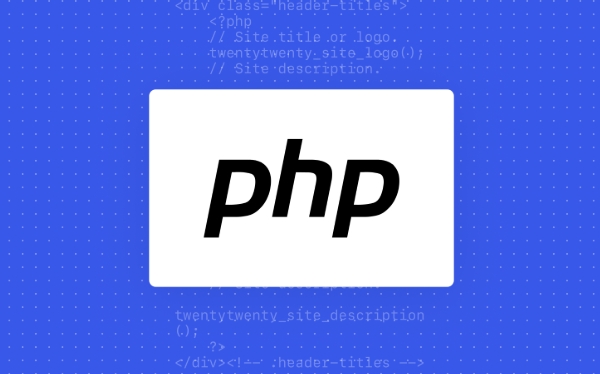In PHP, there are mainly the following methods to obtain the day of the week: 1. Use the date() function to combine format characters (such as 'w', 'N', 'l', 'D') to directly return the value or name of the day of the week; 2. Use the DateTime class to implement more flexible date processing, and support advanced functions such as time zones; 3. Use strtotime() to process custom date strings, which are suitable for database, user input and other scenarios; 4. Encapsulate helper functions to implement code reuse and simplify calls. These methods can be selected and used according to specific needs.

If you're working with dates in PHP and need to get the day of the week from a date, there are a few straightforward ways to do it. PHP provides built-in functions that make this task simple, whether you want the numeric representation (like 0 for Sunday or 1 for Monday), or the actual name (like "Monday").

Using date() with a Timestamp
The most common way to get the day of the week is by using the date() function. You can use different format characters depending on what you need:
-
'w'— returns the numeric day of the week (0 = Sunday, 1 = Monday, ..., 6 = Saturday) -
'N'— returns the ISO-8601 numeric day of the week (1 = Monday, ..., 7 = Sunday) -
'l'(lowercase L) — returns the full textual representation (eg, "Monday") -
'D'— returns the abbreviated textual version (eg, "Mon")
Example:

echo date('l'); // Outputs something like "Wednesday" echo date('D'); // Outputs "Wed" echo date('w'); // Outputs "3" (if today is Wednesday) echo date('N'); // Outputs "3" (if today is Wednesday)
This method works well when you're dealing with the current date or a known timestamp.
Using DateTime for More Flexibility
If you're working with more complex date handling or need to support different time zones, the DateTime class is a better choice. It's object-oriented and offers more control.

Here's how you can get the day of the week using DateTime :
$date = new DateTime(); echo $date->format('l'); // Full name, eg, "Wednesday"
You can also use it with a specific date string:
$date = new DateTime('2025-04-05'); echo $date->format('D'); // Outputs "Sat"
This approach is especially useful when you need to manipulate or compare dates in your application.
Handling Custom Dates and Formats
Sometimes you might have a date string from a form or a database and need to convert it to a day of the week. You can combine strtotime() with date() for this:
$dateString = '2025-04-06'; $timestamp = strtotime($dateString); echo date('l', $timestamp); // Outputs "Sun"
This works well for:
- Dates stored in a database
- User input dates
- API responses with date strings
Make sure the input date is in a format that strtotime() understands, like YYYY-MM-DD.
If you're not sure about the date format, you might want to validate it first or use DateTime::createFromFormat() for more control.
A Simple Helper Function
If you find yourself needing this functionality in multiple places, you can wrap it in a reusable function:
function getDayOfWeek($dateString = 'now') {
$timestamp = strtotime($dateString);
return date('l', $timestamp);
}
echo getDayOfWeek('2025-04-05'); // Outputs "Saturday"- You can change
'l'to'D','w', or'N'depending on the format you want. - The default is
'now', so if no date is passed, it uses the current date.
This function is lightweight and handy in templates or forms where you just need to display the day.
That's basically it. Whether you're formatting dates for display, checking business days, or validating schedules, getting the day of the week in PHP is pretty straightforward with these tools.
The above is the detailed content of php function to get the day of the week. For more information, please follow other related articles on the PHP Chinese website!

Hot AI Tools

Undress AI Tool
Undress images for free

Undresser.AI Undress
AI-powered app for creating realistic nude photos

AI Clothes Remover
Online AI tool for removing clothes from photos.

Clothoff.io
AI clothes remover

Video Face Swap
Swap faces in any video effortlessly with our completely free AI face swap tool!

Hot Article

Hot Tools

Notepad++7.3.1
Easy-to-use and free code editor

SublimeText3 Chinese version
Chinese version, very easy to use

Zend Studio 13.0.1
Powerful PHP integrated development environment

Dreamweaver CS6
Visual web development tools

SublimeText3 Mac version
God-level code editing software (SublimeText3)
 PHP Variable Scope Explained
Jul 17, 2025 am 04:16 AM
PHP Variable Scope Explained
Jul 17, 2025 am 04:16 AM
Common problems and solutions for PHP variable scope include: 1. The global variable cannot be accessed within the function, and it needs to be passed in using the global keyword or parameter; 2. The static variable is declared with static, and it is only initialized once and the value is maintained between multiple calls; 3. Hyperglobal variables such as $_GET and $_POST can be used directly in any scope, but you need to pay attention to safe filtering; 4. Anonymous functions need to introduce parent scope variables through the use keyword, and when modifying external variables, you need to pass a reference. Mastering these rules can help avoid errors and improve code stability.
 How to handle File Uploads securely in PHP?
Jul 08, 2025 am 02:37 AM
How to handle File Uploads securely in PHP?
Jul 08, 2025 am 02:37 AM
To safely handle PHP file uploads, you need to verify the source and type, control the file name and path, set server restrictions, and process media files twice. 1. Verify the upload source to prevent CSRF through token and detect the real MIME type through finfo_file using whitelist control; 2. Rename the file to a random string and determine the extension to store it in a non-Web directory according to the detection type; 3. PHP configuration limits the upload size and temporary directory Nginx/Apache prohibits access to the upload directory; 4. The GD library resaves the pictures to clear potential malicious data.
 Commenting Out Code in PHP
Jul 18, 2025 am 04:57 AM
Commenting Out Code in PHP
Jul 18, 2025 am 04:57 AM
There are three common methods for PHP comment code: 1. Use // or # to block one line of code, and it is recommended to use //; 2. Use /.../ to wrap code blocks with multiple lines, which cannot be nested but can be crossed; 3. Combination skills comments such as using /if(){}/ to control logic blocks, or to improve efficiency with editor shortcut keys, you should pay attention to closing symbols and avoid nesting when using them.
 How Do Generators Work in PHP?
Jul 11, 2025 am 03:12 AM
How Do Generators Work in PHP?
Jul 11, 2025 am 03:12 AM
AgeneratorinPHPisamemory-efficientwaytoiterateoverlargedatasetsbyyieldingvaluesoneatatimeinsteadofreturningthemallatonce.1.Generatorsusetheyieldkeywordtoproducevaluesondemand,reducingmemoryusage.2.Theyareusefulforhandlingbigloops,readinglargefiles,or
 Tips for Writing PHP Comments
Jul 18, 2025 am 04:51 AM
Tips for Writing PHP Comments
Jul 18, 2025 am 04:51 AM
The key to writing PHP comments is to clarify the purpose and specifications. Comments should explain "why" rather than "what was done", avoiding redundancy or too simplicity. 1. Use a unified format, such as docblock (/*/) for class and method descriptions to improve readability and tool compatibility; 2. Emphasize the reasons behind the logic, such as why JS jumps need to be output manually; 3. Add an overview description before complex code, describe the process in steps, and help understand the overall idea; 4. Use TODO and FIXME rationally to mark to-do items and problems to facilitate subsequent tracking and collaboration. Good annotations can reduce communication costs and improve code maintenance efficiency.
 How to access a character in a string by index in PHP
Jul 12, 2025 am 03:15 AM
How to access a character in a string by index in PHP
Jul 12, 2025 am 03:15 AM
In PHP, you can use square brackets or curly braces to obtain string specific index characters, but square brackets are recommended; the index starts from 0, and the access outside the range returns a null value and cannot be assigned a value; mb_substr is required to handle multi-byte characters. For example: $str="hello";echo$str[0]; output h; and Chinese characters such as mb_substr($str,1,1) need to obtain the correct result; in actual applications, the length of the string should be checked before looping, dynamic strings need to be verified for validity, and multilingual projects recommend using multi-byte security functions uniformly.
 Quick PHP Installation Tutorial
Jul 18, 2025 am 04:52 AM
Quick PHP Installation Tutorial
Jul 18, 2025 am 04:52 AM
ToinstallPHPquickly,useXAMPPonWindowsorHomebrewonmacOS.1.OnWindows,downloadandinstallXAMPP,selectcomponents,startApache,andplacefilesinhtdocs.2.Alternatively,manuallyinstallPHPfromphp.netandsetupaserverlikeApache.3.OnmacOS,installHomebrew,thenrun'bre
 Learning PHP: A Beginner's Guide
Jul 18, 2025 am 04:54 AM
Learning PHP: A Beginner's Guide
Jul 18, 2025 am 04:54 AM
TolearnPHPeffectively,startbysettingupalocalserverenvironmentusingtoolslikeXAMPPandacodeeditorlikeVSCode.1)InstallXAMPPforApache,MySQL,andPHP.2)Useacodeeditorforsyntaxsupport.3)TestyoursetupwithasimplePHPfile.Next,learnPHPbasicsincludingvariables,ech






